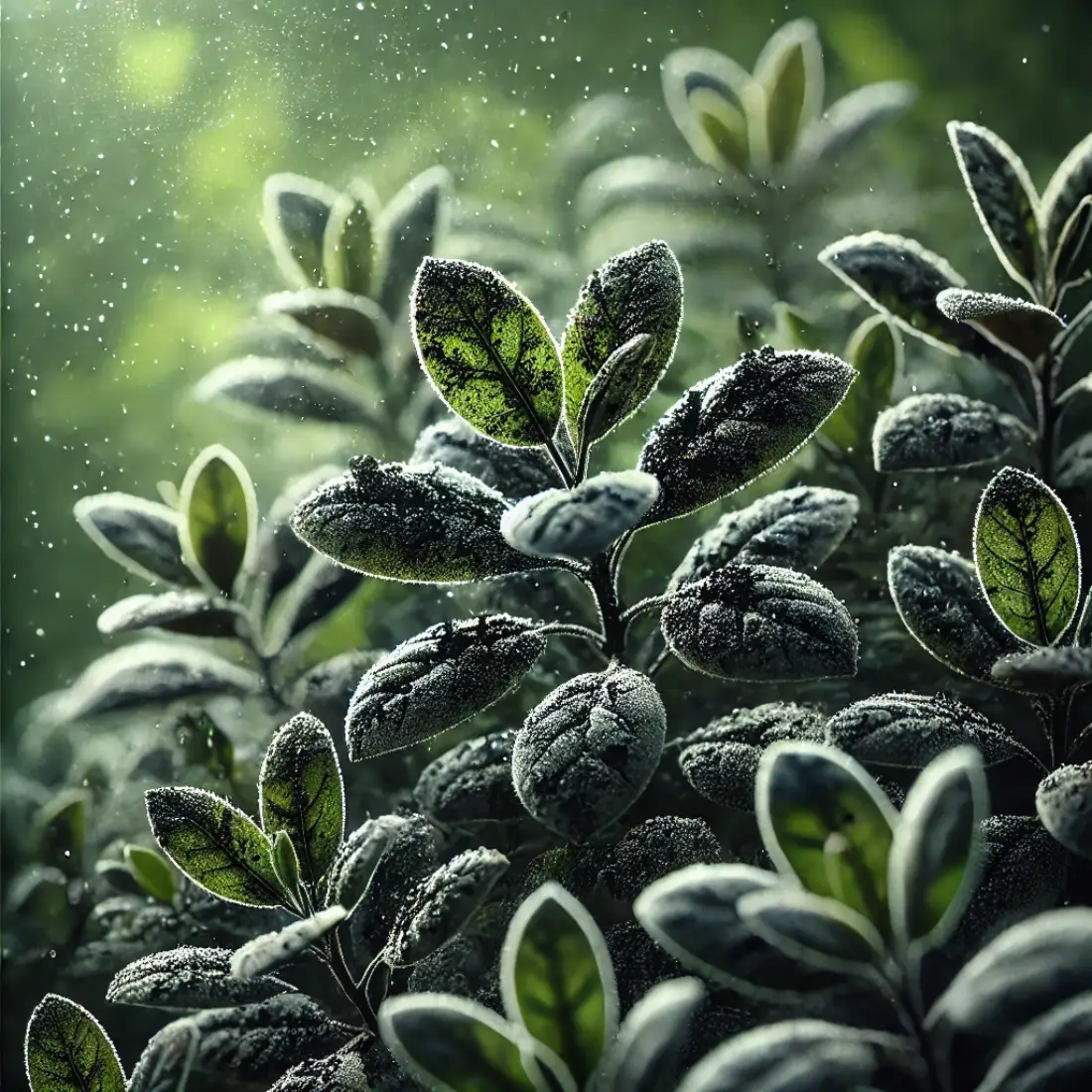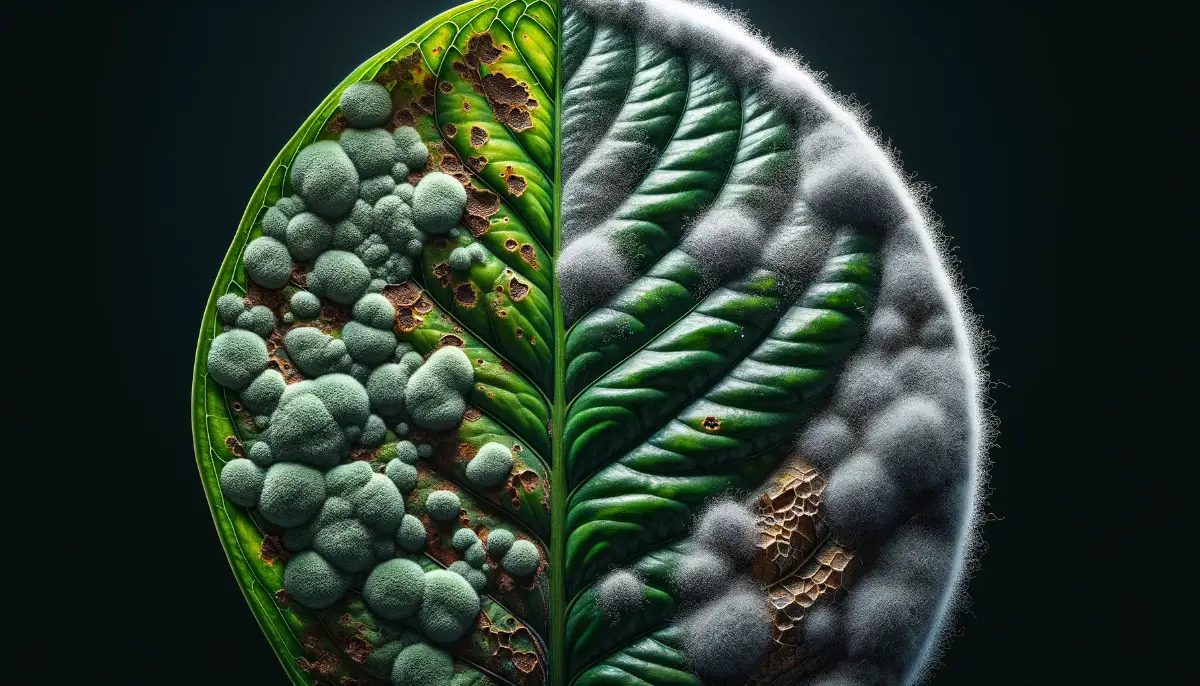Sooty mold is a common fungal problem that affects a wide variety of plants, leaving a distinctive black, sooty coating on leaves and stems. This unsightly mold can hinder photosynthesis, weakening plants and making them more susceptible to other diseases. Using organic methods to control sooty mold is essential for maintaining a healthy, vibrant garden without resorting to harsh chemicals.
- Understanding Sooty Mold: A black, sooty fungus caused by sap-feeding insects.
- Symptoms: Black coating on leaves and stems, hindering photosynthesis.
- Impact: Weakens plants, leading to stunted growth.
- Organic Control: Use proper watering, pruning, beneficial insects, homemade sprays (neem oil, baking soda), and organic fungicides.
- Prevention: Maintain healthy soil, monitor regularly, and intervene early.
What is Sooty Mold?
Sooty mold is a black, sooty fungal growth on the leaves, stems, and branches of plants. It doesn’t infect plant tissues directly but grows on the sugary honeydew excreted by sap-feeding insects.
Plants commonly affected include citrus trees, gardenias, azaleas, camellias, and various fruit trees like apples and plums. Vegetables such as beans and tomatoes can also be affected, especially if infested with sap-feeding insects.
Sooty mold grows on honeydew produced by sap-feeding insects like aphids, whiteflies, and scale insects. The presence of these insects on plants is the primary cause of sooty mold.
Aphids, whiteflies, and scale insects excrete honeydew while feeding on plant sap. This honeydew creates an ideal environment for sooty mold fungi to thrive. Controlling these insects is crucial for preventing sooty mold.

High humidity, warm temperatures, and poor air circulation promote both sap-feeding insects and sooty mold growth. Dense plantings and overcrowded conditions exacerbate the problem by hindering air movement and creating a favorable microclimate for mold.
Symptoms and Visual Signs on Plants
Sooty mold appears as a black, sooty coating on leaves, stems, and branches. It can range from a thin, powdery layer to a thick, crusty layer, depending on infestation severity. Affected plants may also show signs of insect activity like sticky leaves.
Sooty mold grows on the plant surface and can be wiped off or washed away, unlike fungal infections that damage plant tissues. It doesn’t directly harm plants but blocks sunlight, reducing photosynthesis. This leads to stunted growth, yellowing leaves, and reduced vigor. Severe cases may cause premature leaf drop, further weakening the plant.
Organic Methods of Control
Cultural Practices to Prevent Sooty Mold
Proper Watering and Irrigation Techniques: Ensuring plants receive adequate water without overwatering is crucial. Use drip irrigation or soaker hoses to keep water off the foliage, reducing the chances of mold growth.
Pruning and Plant Spacing for Better Air Circulation: Regular pruning helps improve air circulation around the plants, reducing humidity levels and making the environment less favorable for sooty mold. Proper plant spacing also prevents overcrowding, further enhancing air flow.
Regular Monitoring and Early Detection: Inspect plants frequently for early signs of sap-feeding insects and sooty mold. Early detection allows for prompt intervention, preventing the spread and establishment of the mold.
Biological Control Methods
Beneficial Insects: Introduce natural predators like ladybugs, lacewings, and parasitic wasps to control populations of aphids, whiteflies, and scale insects. These beneficial insects help reduce the honeydew production that fosters sooty mold growth.
Natural Predators and Parasites: Encourage birds and other natural predators to frequent your garden by providing suitable habitats. This can help keep the population of sap-feeding insects in check.
Insecticidal Soaps and Oils: Use insecticidal soaps and horticultural oils, such as neem oil, to control sap-feeding insect populations. These products are safe for the environment and effectively reduce insect numbers, minimizing honeydew and sooty mold.
Homemade Organic Sprays
Neem Oil Spray: Mix neem oil with water and a few drops of dish soap. Spray this solution on affected plants to control sap-feeding insects and inhibit mold growth.
Baking Soda and Water Spray: Combine baking soda, water, and a small amount of dish soap to create a spray that helps prevent and treat sooty mold. Apply regularly to affected plants.
Garlic and Hot Pepper Spray: Blend garlic and hot peppers with water, strain the mixture, and use it as a spray to repel sap-feeding insects. This reduces honeydew production and subsequent mold growth.
Using Organic Fungicides: Organic fungicides like sulfur and copper-based products can be effective against sooty mold. They help reduce the fungal population without harming the environment.
Apply organic fungicides according to the manufacturer’s instructions, ensuring thorough coverage of affected areas. Wear protective gear and avoid inhaling the products.
While organic fungicides can help manage sooty mold, they may need to be used in conjunction with other control methods for the best results. Regular applications may be necessary.
Soil Management and Plant Health
- Healthy soil promotes strong plant growth, making plants more resistant to pests and diseases. Use organic compost and fertilizers to improve soil health.
- Incorporate organic fertilizers and compost into the soil to provide essential nutrients and support beneficial soil microorganisms that help suppress mold growth.
- Maintain the proper soil pH for your plants. Use soil amendments like lime to adjust pH levels as needed, promoting optimal plant health and resilience against sooty mold.
FAQs about Sooty Mold
What are the first signs of sooty mold on plants?
The initial signs of sooty mold include a black, sooty coating on the leaves, stems, and branches. You may also notice a sticky substance, known as honeydew, produced by sap-feeding insects like aphids, whiteflies, and scale insects.
Can sooty mold kill my plants?
Sooty mold itself does not kill plants, but it can weaken them by blocking sunlight, which reduces photosynthesis. This can lead to stunted growth and overall poor plant health. If left untreated, the underlying insect infestation causing the mold can cause significant damage.
How do I prevent sooty mold from returning?
Preventing sooty mold involves controlling the sap-feeding insects that produce honeydew. Regular monitoring, proper watering practices, pruning, and introducing beneficial insects can help keep these pests in check and prevent sooty mold from recurring.
Are there any specific plants more susceptible to sooty mold?
Yes, plants like citrus trees, gardenias, azaleas, camellias, and various fruit trees such as apples and plums are particularly susceptible to sooty mold, especially when infested with sap-feeding insects.
How often should I apply organic sprays for sooty mold control?
The frequency of application depends on the severity of the infestation. Typically, you should apply organic sprays every 7-10 days until the mold and insect population are under control. Follow the instructions on the product label for best results.
Can household ingredients be used to control sooty mold?
Yes, household ingredients like baking soda, neem oil, and garlic can be effective in managing sooty mold. These ingredients can be made into sprays that help control both the mold and the insects producing honeydew.
Is it safe to use neem oil on all plants?
Neem oil is generally safe for most plants, but it is always best to test a small area of the plant first to ensure there are no adverse reactions. Avoid using neem oil on plants in direct sunlight to prevent leaf burn.
What environmental conditions favor sooty mold growth?
Sooty mold thrives in high humidity, warm temperatures, and poor air circulation. Overcrowded plantings and dense foliage can create microclimates that are ideal for mold growth and the sap-feeding insects that produce honeydew.
Can sooty mold affect indoor plants?
Yes, indoor plants can also be affected by sooty mold if they are infested with sap-feeding insects. Proper ventilation, regular monitoring, and insect control measures can help prevent sooty mold on indoor plants.
What is the role of beneficial insects in controlling sooty mold?
Beneficial insects like ladybugs, lacewings, and parasitic wasps prey on sap-feeding insects such as aphids, whiteflies, and scale insects. By reducing the population of these pests, beneficial insects help decrease the amount of honeydew and, consequently, the growth of sooty mold.










